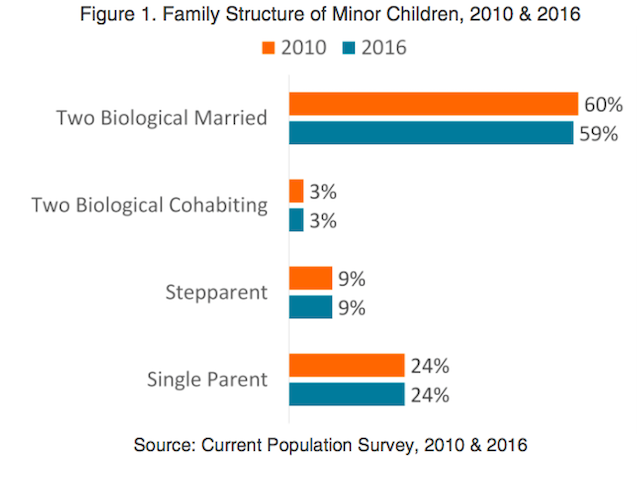Highlights
At a time when all of us could really use some good news for a change, there is some positive information to report about the American family. Family life for U.S. children appears to have stabilized in recent years, at least when it comes to the structure of children’s families. That's according to a new series of profile reports from the National Center for Family and Marriage Research (NCMFR) at Bowling Green State University, which analyzed data from the 2010 and 2016 Current Population Survey (CPS) and found “essentially no change in children’s family structure since 2010.” Here are three key takeaways from each of the NCFMR reports:
1. Married-biological-parent families are still the norm. The majority of children (62%) live with their two biological parents. Most children living with two biological parents are being raised by married parents (59%), while only 3% are living with cohabiting biological parents. And, as illustrated in the figure below, that has remained virtually unchanged since 2010.

Source: Eikmeyer, K., "American Children's Family Structure: Two Biological Parent Families," FP-17-15, National Center for Family & Marriage Research.
This report also indicates that children in married-parent families are significantly less likely to live in poverty compared to cohabiting parents: 91% of children in married families live above the poverty line, compared to 54% of children in cohabiting-biological parent families. Even when the incomes and non-cash benefits of both cohabiting parents are factored in, married-parent families are still less likely to be in poverty. While accounting for these factors drops the percentage of children in poor cohabiting families by nearly half (to 24%), the report states that "these children were still not as financially secure as their counterparts with married parents."
2. The share of children being raised by a single parent remains stable. In the figure below, we see that 24% of children live with single parents—the same percentage as in 2010 (see the previous figure). Most of these children are living with single mothers (21%), while 3% live with single fathers.

Source: Eikmeyer, K., "American Children's Family Structure: Single-Parent Families," FP-17-17, National Center for Family & Marriage Research.
Comparing children in single-father and single-mother families, the report shows that children being raised by their single mothers are more likely to be poor than those living with single fathers: 39% of children in single-mother families are living below the federal poverty line, compared to 19% of children in single-father families.
When it comes to education, single fathers are more likely (23%) than single mothers (18%) to have a college degree. About equal shares of children living with single mothers are black and white, but “over twice as many children living with single mothers identified as black than children living with single fathers.”
3. Children living in stepparent families are more likely than those living with both biological parents to be living in cohabiting families. Nine percent of children in both 2010 and 2016 were being raised in stepparent families (defined as a biological parent and his or her married or cohabiting partner). Of those, just over half live in married-parent families, while 45% live in cohabiting stepparent families.
Although most stepparent families are living above the federal poverty line, children in cohabiting stepparent families are significantly more likely to be living in poverty than those living with married stepparents. According to the report, “The share of children living in poverty with cohabiting stepparents (40%) was three times higher than those living with married stepparents (12%).” When noncash benefits and both partner’s incomes are included by using the Census Bureau’s supplemental poverty measure (indicated by the dotted line below), the percentage of children living with a cohabiting stepparent in poverty decreases from 40% to 20%.

Source: Eikmeyer, K., "American Children's Family Structure: Stepparent Families," FP-17-16, National Center for Family & Marriage Research.
Much has been written, including on this blog, about the changes to the American family over the past 25 years, from the rise in cohabitation and unmarried parenthood, especially among younger Americans, to the growing marriage divide between the higher educated and the less educated. Despite these trends, however, we can take heart in the news that in recent years at least, the structure of most U.S. children's families has not changed in significant ways. The majority are living with their own parents in married families, where they are significantly less likely than children in other family forms to experience poverty and the instability that too often results when marriage is absent or breaks down. Perhaps the married biological parent family has more staying power than we thought.
Alysse ElHage is the editor of the Institute for Family Studies blog.
Editor's Note: The views and opinions expressed in this article are those of the author and do not necessarily reflect the official policy or views of the Institute for Family Studies.















